10 Passive
In this chapter, we first present some general characteristics of
the passive and then a movement analysis of it. Although superficially
the passive does not resemble subject raising, our analysis of it treats
the two constructions as analogous in important respects. Moreover,
subject raising turns out to be analogous not just to the passive of
simple sentences, but also to the passive of sentences with ECM verbs.
All three phenomena (simple passive, subject raising, passive of ECM)
turn out to obey a correlation
called Burzio's
generalization, according to which verbs that lack an
agent argument also lack the ability to check case. We show further
that there are two types of case, structural and inherent, and that
Burzio's generalization holds only for structural case. Finally, we
discuss the passive of double object sentences in English on the one
hand and in German and Latin on the other.
Characteristics of the passive
In English, as in most other languages, active sentences like (1a)
have passive counterparts like (1b).
| (1)
| a.
| Active:
|
| Nancy
| approved
| them.
|
|
| Thematic role
|
| Agent
|
| Theme
|
|
| Grammatical relation
|
| Subject
|
| Direct object
|
|
| b.
| Passive:
|
| They
| were approved
| (by
| Nancy).
|
|
| Thematic role
|
| Theme
|
| Agent
|
|
| Grammatical relation
|
| Subject
|
| Object of preposition
|
Passivization has a number of effects. First and foremost, the
agent argument, which is expressed as the subject of the active
sentence, appears in the passive as an optional by phrase.
Second, the now vacant subject position is taken over by the theme
argument. In other words, the agent and theme arguments are linked to
different grammatical
relations in the passive than in the active. If subject
ranks higher than object on a hierarchical scale of grammatical
relations (as is often assumed), then the passive demotes the agent
argument and promotes the theme argument. Third, passive past
participles, unlike their homonymous active counterparts, can't check
objective case.
| (2)
| a.
| Active:
| ✓
| Nancy has approved them.
|
|
| b.
| Passive:
| *
| Itexpl was approved them.
|
|
| Intended meaning: 'They were approved.'
|
In English, the passive is expressed analytically by a combination
of the past
participle and an auxiliary verb (be or get). Other
languages allow the passive to be expressed synthetically, as
illustrated in (3) for Korean and in (4) for Latin.
| (3)
| a.
| Active:
| ✓
| Chulswu-ka kyehoyk-ul helak-ha-yessta.
Chulswu-nom plans-acc approve-active-past
Agent Theme
Subject Direct object
'Chulswu approved the plans.'
|
|
| b.
| Passive:
| ✓
| Kyehoyk-i (chulswu-eyuyhaye) helak-toy-essta.
plans-nom Chulswu-by approve-passive-past
Theme Agent
Subject Object of postposition
'The plans were approved (by Chulswu).'
|
| (4)
| a.
| Active:
| ✓
| Puer-i port-am claud-unt.
boy-nom.pl.m door-acc.sg.f close-3.pl.pres
Agent Theme
Subject Direct object
'The boys are closing the door.'
|
|
| b.
| Passive:
| ✓
| Port-a (a puer-is) claud-it-ur.
door-nom.sg.f by boy-abl.pl.m close-3.sg.pres-passive
Theme Agent
Subject Object of preposition
'The door is being closed (by the boys).'
|
In these languages, it is the bound morphemes -toy- and
-ur that result in the effects of passivization mentioned above.
As in English, the grammatical relations of the agent and theme
arguments differ in the active and the passive, and passive verb forms
cannot check the case that active verb forms can.
| (5)
| a.
|
| *
| Kyehoyk-ul (chulswu-eyuyhaye) helak-toy-essta.
plans-acc Chulswu-by approve-passive-past
Intended meaning: 'The plans were approved (by Chulswu).'
|
|
| b.
|
| *
| Port-am (a puer-is) claud-it-ur.
door-acc.sg.f. by boy-abl.pl.m. close-3.sg.pres-passive
Intended meaning: 'The door is being closed by the boys.'
|
Latin (among other languages) also uses the analytic strategy for
the passive in certain linguistic contexts. In particular, the passive
voice in the present perfect, past perfect, and future perfect is formed
by combining the passive participle with the appropriate form
of esse 'be', as illustrated in (6).
| (6)
|
|
| ✓
| Port-a (a puer-is) claus-a { est, erat, erit } .
door-nom.sg.f by boy-abl.pl.m close-part.pass.nom.sg.f is was will.be
Theme Agent
Subject Object of preposition
'The door { has, had, will have } been closed (by the boys).'
|
It is worth noting that the synthetic passive form in (4b) agrees
with the subject in number, but that the participle in the analytic form
in (6) shows additional case and gender agreement. Case and gender are
ordinarily features of the nominal system (nouns and their canonical
modifiers, adjectives), so participles share features of both verbs and
adjectives. Indeed, the term 'participle' implies as much, as it
derives from Latin particeps 'sharing'.
A movement analysis of the passive
Object idiom chunks
In addition to the subject idiom chunks discussed in
Chapter 9, English also
has object idiom chunks, which generally appear as the
complements of the verbs that license
them.2 Some examples are
given in (7) (Radford 1988:422). The object idiom
chunks are underlined, and the licensing verbs are in green.
| (7)
| a.
| ✓
| They are making some headway on
a solution.
|
|
| b.
| ✓
| They will { give,
pay } little heed to her proposal.
|
|
| c.
| ✓
| She took little note of what I said.
|
|
| d.
| ✓
| The government keeps close tabs on
his operations.
|
The restriction of object idiom chunks to the complement position of
the licensing verb is thrown into striking relief by the contrast between
nearly synonymous expressions such as attention and heed, or
progress and headway (Radford 1988:423).
The variants with the ordinary expressions (attention, progress) are
fine, but those with the idiom chunks (heed, headway) are not
since they are not licensed by the verbs in red.
| (8)
| a.
|
| Please be prepared to report some
{ progress, *headway } by Monday.
|
|
| b.
|
| We appreciate your { progress,
*headway } in solving the problem.
|
| (9)
| a.
|
| They're always trying to attract my
{ attention, *heed . }
|
|
| b.
|
| Some children require a lot of
{ attention, *heed . }
|
Given their licensing requirements, it isn't surprising that object
idiom chunks are generally ungrammatical in subject position.
| (10)
| a.
|
| { Attention, *heed } facilitates learning.
|
|
| b.
|
| More { attention, *heed } to maintenance
would soon pay off in lower repair bills.
|
|
| c.
|
| { Progress, *headway } is often slower
than one expects.
|
They are, however, able to occur in subject position under one
condition - in passive sentences where the passive participle is that of
the licensing verb. This is illustrated by the contrast between (11)
and (12) (Radford 1988:423).
| (11)
| a.
| ✓
| Some headway is being made on
a solution.
|
|
| b.
| ✓
| Little heed was paid to her
proposal.
|
|
| c.
| ✓
| Due homage was paid to the dead.
|
|
| d.
| ✓
| Little note was taken of what I said.
|
|
| e.
| ✓
| Close tabs were kept on his
operations.
|
| (12)
| a.
| *
| My heed was attracted immediately.
|
|
| b.
| *
| Your close heed is required.
|
|
| c.
| *
| A bit of headway was reported at the
meeting.
|
|
| d.
| *
| Our headway in solving the problem wasn't sufficiently
appreciated.
|
Analysis
We now turn to an analysis of the passive that takes into consideration
the facts that we have just presented. We begin by recalling the key
assumption of the analysis of subject raising
in Chapter 9 - namely,
that nonthematic subjects invariably originate as specifiers of their
licensing predicates. A straightforward consequence of this assumption
is that when nonthematic subjects function as the subjects of a higher
clause, they must have moved there from their original position. We can
think of this process of subject raising as extending (stretching, as it
were) the relation between a nonthematic subject and its licenser
without giving up the locality of the licensing relationship, which is
preserved by the lowest trace in the
movement chain.
As we have just seen, object idiom chunks in active sentences are
locally licensed as well - namely, as the complements of a licensing
verb, and this local relationship is extended in passive sentences. In
other words, although the licensing relationship differs in both cases
(spec-predicate for subject raising, head-comp for passive), the passive
is analogous to subject raising in that both constructions superficially
extend a local licensing relationship. This fundamental similarity
motivates our treatment of the passive as another instance of syntactic
movement.
Our movement analysis of the passive is based on the premise that
theme arguments originate in the same structural position in both the
active and the passive. This means that the elementary trees for active
and passive participles both contain a complement position. However,
the relevant elementary trees differ in two important ways. First, in
the active, the agent argument is obligatorily linked
to (= expressed in) Spec(VP), whereas in the passive,
it is linked to an optional adjunct by phrase. We will represent
this by omitting Spec(VP) in the elementary tree for the passive
participle. Second, passive participles in English cannot check
objective case; recall the ungrammaticality of (2b). (We will generally
not represent this property in the elementary tree explicitly.) The
elementary trees we propose for active and passive participles are thus
as shown in (13).
| (13)
| a.
|
| 
|
| b.
|
| 
|
|
| Active verb: [+obj]
|
| Passive verb: [-obj]
|
Burzio 1986 was the first
to note the correlation between the two above-mentioned properties and
to propose the generalization in (14).
| (14)
|
|
| Burzio's generalization:
A verb form that does not express an agent argument in the specifier
position cannot check objective case.
|
In what follows, we illustrate the derivation of a passive sentence
like (15).
| (15)
|
|
| The proposal was adopted.
|
First, we substitute the theme argument the proposal in the
elementary tree for the passive main verb in (13b). This yields (16a).
We next substitute (16a) as the complement of the passive auxiliary
verb be, as in (16b). In order to distinguish the auxiliary verb
(be) from the main verb (adopted), we give it the
syntactic category Aux, but we could just as easily treat it as another
instance of V. We will treat auxiliary verbs, like raising verbs and
passive participles, as lacking specifier positions. We then substitute
the resulting structure as the complement of I, as in (16c).
| (16)
| a.
|
| 
|
| b.
|
| 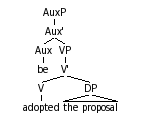
|
| c.
|
| 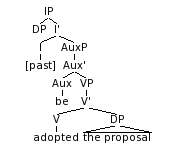
|
|
| Substitute theme argument in (14b)
|
| Substitute (16a) as complement of passive auxiliary
|
| Substitute (16b) as complement of I
|
Because of the inability of the passive participle to check
objective case, the theme argument's case feature cannot be checked in
the complement position. Since every case feature must be checked, the
theme argument must move to the closest position in which case can be
checked. This position is Spec(IP), where it is possible for the theme
argument to check nominative case with finite I. The resulting final
structure is shown in (17). (For simplicity, we omit the verb movement
of the passive auxiliary be from V to I.)
| (17)
|
|
| 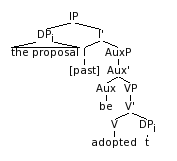
|
According to the analysis just presented, the passive is analogous
to subject raising in the following way. In both cases, a noun phrase
(the subject of the complement clause with subject raising, the object
with passive) originates in a position where case can't be checked.
This forces the relevant noun phrase (complement subject, object) to
move to the closest position where case can be checked. Of course,
subject raising and the passive aren't identical in every respect.
There are two important differences between the two instances of
movement. First, the path from the head of the chain to its tail
contains a clause boundary (IP) in the case of subject raising, but not
in the case of the passive.

| Recall that the term head has two completely different meanings
that shouldn't be confused. The head of an X' structure is the
syntactic category that immediately dominates a word or morpheme and
projects an intermediate and a maximal projection. The head of a
movement chain is the highest element in the chain.
|
| (18)
| a.
|
| 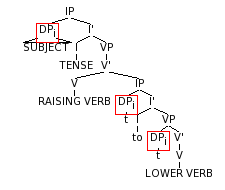
|
| b.
|
| 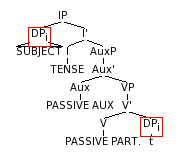
|
|
| Subject raising chain
|
| Passive chain
|
Second, the grammatical relation of the moved noun phrase doesn't
change in subject raising; it starts out as a subject and ends up as
one. In the passive, the grammatical relation of the moved noun phrase
does change - namely, from object to subject.
The passive and nonfinite complementation
This section focuses on the passive of ECM verbs like
expect, which were introduced in connection
with head-spec licensing
in Chapter 8. (19a) shows an active ECM verb sentence, and
(19b) shows the corresponding passive.
| (19)
| a.
| ✓
| Your folks expect you to call.
|
|
| b.
| ✓
| You are expected to call.
|
The elementary tree for expect in (19a) is given in (20a).
In accordance with the previous discussion, the elementary tree for the
passive participle expected is as in (20b). The difference
between the two trees is analogous to that
between the trees in (13); the only
difference is the syntactic category of the complement (DP in the case
of ordinary verbs, IP in the case of ECM verbs). Like (14b), the
elementary tree (20b) is missing a specifier position, and in accordance
with Burzio's generalization, the verb lacks the ability to check
objective case.
| (20)
| a.
|
| 
|
| b.
|
| 
|
|
| Active verb: [+obj]
|
| Passive verb: [-obj]
|
In what follows, we illustrate the derivation of (19b). The derivation
of the complement clause is shown in (21); we assume that the complement
subject moves from Spec(VP) to Spec(IP) to provide the complement clause
with a subject (recall the subject
requirement discussed in Chapter 3).
| (21)
| a.
|
| 
|
| b.
|
| 
|
| c.
|
| 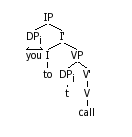
|
|
| Structure of complement VP
|
| Substitute (21a) as complement of nonfinite I
|
| Move subject of complement clause
|
The subsequent steps of the derivation involving the matrix clause are
as shown in (22).
| (22)
| a.
|
| 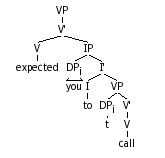
|
| b.
|
| 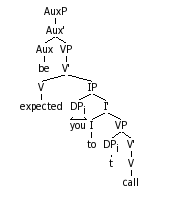
|
| c.
|
| 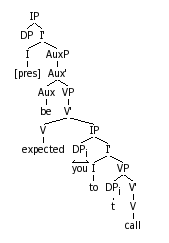
|
|
| Substitute (21c) as complement of passive participle of ECM verb
|
| Substitute (22a) as complement of passive auxiliary
|
| Substitute (22b) as complement of matrix I
|
In (22c), the subject of the complement clause cannot check case
with the participle of the ECM verb in the head-spec configuration
because the participle, being passive, lacks the ability to check case.
Therefore, the complement subject must move to the nearest position
where case can be checked. This is the matrix Spec(IP), where
nominative case is checked. The resulting structure is shown in (23).
(Once again, we omit V to I raising of the passive auxiliary for
simplicity.)
| (23)
|
|
| 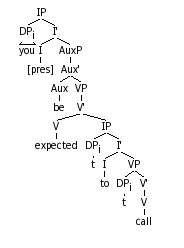
|
Consider now the chain headed by you in (23). The chain
consists of three links, which occupy the matrix Spec(IP), the
complement Spec(IP), and the complement Spec(VP). Chains with links in
these same three positions are also the result of subject raising, as we
saw most recently in (18a). In this respect, then, the passive of ECM
verbs is analogous to subject raising, as is evident from comparing the
schematic structures in (24). The only difference is that the structure
of ECM passives is slightly more complex because the matrix clause
contains a passive auxiliary in addition to the main verb.
| (24)
| a.
|
| 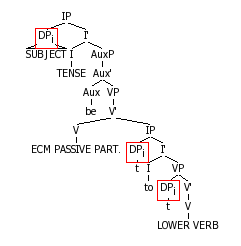
|
| b.
|
| 
|
|
| ECM passive chain
|
| Subject raising chain
|
The common source for the analogous chains in (18) and (24) is that
ordinary passive verbs, subject raising verbs, and passive ECM verbs all
lack a specifier position, as shown in (25), and therefore (by Burzio's
Generalization) the ability to check case.
Although Burzio's generalization itself remains to be explained, it does
allow us to understand the ungrammaticality of all three sentences in
(26) as stemming from a single source. In all three sentences, the head
(highlighted in italics), fails to be associated with an agent and hence
fails to project Spec(VP),3
yet case would have to be checked on the underlined noun phrases
contrary to Burzio's generalization, whether in the head-comp
configuration, as in (26a), or in the head-spec configuration, as in
(26b,c).
| (26)
| a.
| Ordinary passive:
| *
| Itexpl was approved them.
|
|
| b.
| Raising:
| *
| Itexpl seems [ him to have a problem. ]
|
|
| c.
| ECM passive:
| *
| Itexpl is expected [ him to have a problem. ]
|
Structural versus inherent case
In languages with morphologically richer case systems than English,
there is evidence for a distinction between two types of case:
structural and inherent. For instance, the following
German examples show that the active participle unterstützt
'supported' checks accusative case, but that the homonymous passive
participle cannot. Instead, in the passive, nominative case on the
theme argument is checked by finite I, as in English.

| The German examples in this section are given in the form of
subordinate clauses in order to abstract away from a syntactic
constraint on main clauses in the Germanic languages other than English
that is irrelevant for present purposes; this so-called V2 constraint is
discussed in Chapter 14.
|
| (27)
|
| Active:
| ✓
| dass wir dies-en Kandidat-en unterstützt haben
that we this-acc candidate-acc supported have
'that we have supported this candidate'
|
| (28)
| a.
| Passive:
| ✓
| dass dies-er Kandidat unterstützt wurde
that this-nom candidate.nom supported became
'that this candidate was supported'
|
|
| b.
|
| *
| dass dies-en Kandidat-en unterstützt wurde
that this-acc candidate-acc supported became
Intended meaning: 'that this candidate was supported'
|
German also allows verbs to check the dative. Such verbs - for
instance, helfen 'help' - continue to check the dative even in
passive sentences, as shown in (29) and
(30).4
| (29)
|
| Active:
| ✓
| dass wir dies-em Kandidat-en geholfen haben
that we this-dat candidate-dat helped have
'that we helped this candidate'
|
| (30)
| a.
| Passive:
| *
| dass dies-er Kandidat geholfen wurde
that this-nom candidate.nom helped became
Intended meaning: 'that this candidate was helped'
|
|
| b.
|
| ✓
| dass dies-em Kandidat-en geholfen wurde
that this-dat candidate-dat helped became
'that this candidate was helped'
|
The accusative and the dative are both checked in the head-comp
configuration by the verbs unterstützen 'support'
and helfen 'help', respectively, but they differ in that the
accusative alternates with the nominative, whereas the dative
doesn't. What we mean by 'alternate' is simply that an accusative
object in the active corresponds to a nominative subject in the passive,
whereas a dative object in the active remains dative in the passive.
The alternating cases (nominative, accusative) are known
as structural cases (because which one occurs depends on the
structural position of the argument bearing the case), whereas the
nonalternating case (dative) is known as an inherent case.
The distinction between structural and inherent case has
consequences for the formulation of Burzio's generalization. In view of
the facts just presented, it holds only for verbs that check structural
case.
| (31)
|
|
| Burzio's generalization (revised formulation):
A verb form that does not express an agent argument in the specifier
position cannot check structural case.
|
An important question that arises in connection with (30b) is what
element checks the nominative case feature of the finite I. It is
generally assumed that German has a silent expletive element,
corresponding to English expletive it or there, that can
check nominative case in Spec(IP). The structure of (30b) is then as in
(32). (As usual, we omit the V to I movement of the passive auxiliary
werden 'become'.)
| (32)
|
|
| 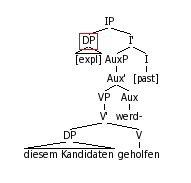
|
The silent expletive bears a number feature with the default value
'singular'. Evidence for this comes from the number agreement pattern
in (33): the overt plural subject in (33a) agrees with a plural verb
form, whereas the silent expletive in (33b) agrees with the
corresponding singular verb form.
| (33)
| a.
| ✓
| dass dies-e Kandidat-en unterstützt { wurd-en, *wurd-e }
that these-nom candidates-nom supported became-pl became-sg
'that these candidates were supported'
|
|
| b.
| ✓
| dass dies-en Kandidat-en geholfen { wurd-e, *wurd-en }
that these-dat candidates-dat helped became-sg became-pl
'that these candidates were helped'
|
Like German, Latin is a verb-final language with rich morphological
case, and it patterns like German with regard to structural versus
inherent case. As in German, the structural cases are nominative and
accusative. The inherent cases include the remaining cases (apart from
the vocative) - that is, the dative, genitive, and ablative. (34)-(37)
illustrate the parallel with German, using the dative as a
representative for the inherent cases.
| (34)
|
| Active:
| ✓
| Avuncul-us puer-os adiuva-t.
uncle-nom.sg boy-acc.pl help-3.sg.pres
'The uncle is helping the boys.'
|
| (35)
| a.
| Passive:
| ✓
| Puer-i adiuva-nt-ur.
boy-nom.pl help-3.pl.pres-passive
'The boys are being helped.'
|
|
| b.
|
| *
| Puer-os adiuva-t-ur.
boy-acc.pl help-3.sg.pres-passive
Intended meaning: 'The boys are being helped.'
|
| (36)
|
| Active:
| ✓
| Avuncul-us puer-is subveni-t.
uncle-nom.sg boy-dat.pl help-3.sg.pres
'The uncle is helping the boys.
|
| (37)
| a.
| Passive:
| *
| Puer-i subveni-unt-ur.
boy-nom.pl help-3.pl.pres passive
Intended meaning: 'The boys are being helped.'
|
|
| b.
|
| ✓
| Puer-is subveni-t-ur.
boy-dat.pl help-3.sg.pres-passive
'The boys are being helped.'
|

| Resume reading here.
|
The passive of double object sentences
In this section, we address the passive of double object sentences.
(38) is a double object sentence of the type discussed
in Chapter 7, and (39) shows that
the recipient, but not the theme, can become the subject of the
corresponding passive.5
| (38)
|
| ✓
| Travis gave Betsy the receipts.
|
| (39)
| a.
| ✓
| Betsy was given the receipts.
|
|
| b.
| *
| The receipts were given Betsy.
|
The grammaticality contrast for English in (39) can be derived
straightforwardly as follows. The active and passive sentences have the
schematic structures in (40) and (41), respectively. For clarity, (41)
shows the structure before and after verb movement.
In (41a), the higher VP shell lacks a specifier position for the
agent, and therefore, by Burzio's generalization, the head is unable to
check structural case. This property is preserved in the complex head
that results from adjoining the lower verb to the higher one, as
highlighted by the boxes. The recipient DP, which in the corresponding
active sentence would check case with the complex verb in the head-spec
configuration, must therefore move out of the VP shell structure. This
yields (39a). In order to derive the ungrammatical (39b), the theme
would have to move, rather than the recipient. But then the resulting
chain would check case twice: the foot of the chain with the objective
case feature on GET and the head of the chain with the nominative case
feature on finite Infl. Meanwhile, the recipient DP would remain in its
original location, unable to check case, exactly as before. As a
result, the passive in (39b) is ungrammatical.

| The rest of this section will not be part of the exam. Resume reading at Notes.
|
Not all languages show the pattern just discussed. German and
Latin, for instance, have exactly the reverse pattern of that in (39);
they allow the theme passive, but not the recipient passive. After
illustrating the pattern for both languages, we propose an explanation
that relies on the distinction just introduced between structural and
inherent case.
In Chapter 8, we saw that German double
object sentences surface with a dative-marked recipient and an
accusative-marked theme. Given the distinction between structural and
inherent case, the question arises of what happens in the passive of
double object sentences in German. As shown in (42) and (43), the
argument with structural case (the theme) can be promoted to subject,
but the argument with inherent case (the recipient) cannot.
| (42)
|
| ✓
| dass ich dem Jungen den Roman gebe
that I.nom the.dat boy.dat the.acc novel give
'that I am giving the boy the novel'
|
| (43)
| a.
| *
| dass der Junge den Roman gegeben wird
that the.nom boy the.acc novel given becomes
Intended meaning: 'that the boy is being given the novel'
|
|
| b.
| ✓
| dass der Roman dem Jungen gegeben wird
that the.nom novel the.dat boy given becomes
'that the novel is being given to the boy'
|
Latin exhibits the same pattern, as shown in (44) and 45).
| (44)
|
| Active:
| ✓
| Avuncul-us puer-is libell-um mitt-it.
uncle-nom.sg boy-dat.pl little.book-acc.sg send-3.sg.pres
'The uncle is sending the boys a little book.'
|
| (45)
| a.
| Passive:
| *
| Puer-i libell-um mitt-unt-ur.
boy-nom.pl book-acc.sg send-3.pl.pres-passive
Intended meaning: 'The boys are being sent a little book.'
|
|
| b.
|
| ✓
| Libell-us puer-is mitt-it-ur.
little.book-nom.sg boy-dat.pl send-3.sg.pres-passive
'The boys are being sent a little book.'
|
As already noted, the German and Latin pattern is exactly the
reverse of that in English: English allows the recipient passive, but
not the theme passive, whereas German and Latin allow the theme passive,
but not the recipient passive.
The German and Latin pattern can be derived as follows. The
schematic structures for the active and the passive are shown in (46)
and (47), respectively. As in (41), (47) shows the structure for the
passive before and after verb movement.
The passive morpheme on the higher V head in (47a) removes the verb's
ability to check structural case (though not its ability to check
inherent case). As before, the properties of the higher head are
preserved after verb movement. What the grammaticality of the theme
passive suggests is that in German and Latin, the complex head's inability to
check structural case is passed down to the adjoined lower verb. In
other words, the passive morpheme affects the ability of the lower verb
(via its trace) to check structural case in the head-comp configuration,
as highlighted by the boxes in (47b). Since the theme argument cannot
check structural case with its sister, it must move. Unlike in English,
the recipient argument can check inherent case with the complex head, so
the resulting (45b) is grammatical.

| Resume reading here.
|
Notes
1. By the
criterion just mentioned, participial constructions as in (i) are true
passive constructions, despite the absence of a passive auxiliary.
| (i)
| a.
|
| The shrubs planted (by our neighbors) are azaleas.
|
|
| b.
|
| Planted in the shade (by an ignorant gardener), the cactus
failed to thrive.
|
Note the close parallel with the constructions in (ii), which
contain a passive auxiliary.
| (ii)
| a.
|
| The shrubs that { were , got } planted (by our neighbors) are azaleas.
|
|
| b.
|
| Having { been, gotten } planted in the shade (by an
ignorant gardener), the cactus failed to thrive.
|
2. Strictly speaking,
the verb-object combinations under discussion might better be referred
to as fixed expressions than as idioms. The so-called idiom chunk has a
very restricted distribution, but the interpretation of the entire
expressions is compositional, unlike in a true idiom.
3. We assume
that expletive it and there in (26) would substitute
directly into Spec(IP).
4. Certain archaic German
verbs govern the genitive, which patterns as an inherent case, as shown
in (i) and (ii), which are parallel to (29) and (30).
| (i)
|
| Active:
| ✓
| dass er der Ahnen gedachte
that he the.gen ancestors commemorated
'that he commemorated the ancestors'
|
| (ii)
| a.
| Passive:
| *
| dass die Ahnen gedacht wurden
that the.nom ancestors commemorated became.pl
Intended meaning: 'that the ancestors were commemorated'
|
|
| b.
|
| ✓
| dass der Ahnen gedacht wurde
that the.gen ancestors commemorated became.sg
'that the ancestors were commemorated'
|
5. At least some
speakers of British English allow the theme passive in (39b), which was
possible in earlier stages of English. In American English, the theme
passive has been entirely replaced by the recipient passive, whereas
British English is not quite as far along in the replacement process.
Exercises and problems
Exercise 10.1
A. Using the xbar ch10 grammar tool, build
structures for the sentences in (1).
| (1)
| a.
|
| The puppeteers might be arrested.
|
|
| b.
|
| The puppeteers were arrested.
|
B. In addition to be, English uses get as
a passive auxiliary, as shown in (2).
| (2)
| a.
|
| The puppeteers might get arrested.
|
|
| b.
|
| The puppeteers got arrested.
|
There is a purely syntactic difference betweeen the two passive
auxiliaries. What is it?
Exercise 10.2
A. Using the xbar ch10 grammar tool, build
structures for the sentences in (1).
| (1)
| a.
| Standard English
|
| The car needs to be washed.
|
|
| b.
| Pittsburgh English
|
| The car needs washed.
|
B. Based on the evidence in (1), compare the syntactic properties
of Standard English versus Pittsburgh English need. Be explicit
but brief.
Exercise 10.3
A. Using the xbar ch10 grammar tool, build
structures for the sentences in (1) and (2).
| (1)
| a.
|
| We expect them to make headway.
|
|
| b.
|
| We expect headway to be made.
|
|
| c.
|
| Headway is expected to be made.
|
| (2)
| a.
|
| The media expect the guerillas to free the journalist.
|
|
| b.
|
| The media expect the journalist to be freed by the guerillas.
|
|
| c.
|
| The journalist is expected to be freed by the guerillas.
|
B. One of the sentences in (2) is structurally ambiguous. Which one
is it, and why?
Exercise 10.4
A. Using the xbar ch10 grammar tool, build
structures for the sentences in (1).
| (1)
| a.
|
| They proved there to be an error in the calculation.
|
|
| b.
|
| There proved to be an error in the calculation.
|
B. Which case is checked on the underlined noun phrases? How do
you know?
C. In which licensing configuration(s) is case checked on the
underlined noun phrases?
D. The syntactic properties of prove differ in (1a) and
(1b). Briefly explain how.
Exercise 10.5
Explain the pattern in (1). Do noun phrases (DPs) differ from clauses
(CPs, IPs) with respect to case-checking?
| (1)
| a.
|
| It was suspected that there was a problem with the O-ring.
|
|
| b.
|
| That there was a problem with the O-ring was suspected.
|
|
| c.
|
| There was suspected to be a problem with the O-ring.
|
|
| d.
| *
| There to be a problem with the O-ring was suspected.
|
Exercise 10.6
Consider the active sentence in (1) and its two theoretically
possible passive counterparts in (2). Both sentences in (2) are
intended to have the same meaning (namely, (2a)). However, as the
contrast in (2) shows, it is grammatical to turn the subject of the
complement clause in (1) into the matrix subject, but ungrammatical to
do the same with the object of the complement clause. Briefly explain
why this is so.
| (1)
|
|
| They will expect her to hire
him.
|
| (2)
| a.
| ✓
| She will be expected to hire
him.
|
|
| b.
| *
| { He, Him } will be expected
{ she, her } to hire.
|
Exercise 10.7
The sentence in (1) is ambiguous. Taking into account the facts in (2),
explain and build the relevant trees.
Hint: See Exercise 9.2 C, D.
| (1)
|
|
| They were determined to be U.S. citizens.
|
| (2)
| a.
| ✓
| They were very determined to be U.S. citizens.
|
|
| b.
| ✓
| They were determined to be U.S. citizens by the INS.
|
|
| c.
| *
| They were very determined to be U.S. citizens by the INS.
|
Problem 10.1
A. The sentences in (1) are taken from answers to homework assignments
for this class from previous years. They are ungrammatical in standard
English. Why?
| (1)
| a.
| *
| The path from I to V is intervened by an illicit node.
|
|
| b.
| *
| In the next sentence, the original subject has been substituted by
a pronoun.
|
B. Omitting the by phrase in the sentences in (1) yields the
grammaticality contrast in (2). Why?
| (2)
| a.
| *
| The path from I to V is intervened.
|
|
| b.
| ✓
| In the next sentence, the original subject has been substituted.
|
Problem 10.2
Consider the facts for the sentences with expect in (1) and (2).
| (1)
| a.
| ✓
| They expected there to be a solution.
|
|
| b.
| ✓
| There was expected to be a solution.
|
| (2)
| a.
| *
| They expected for there to be a solution.
|
|
| b.
| *
| There was expected for to be a solution.
|
Now consider the corresponding facts for sentences with want in
(3) and (4).
| (3)
| a.
| ✓
| They wanted there to be a solution.
|
|
| b.
| *
| There was wanted to be a solution.
|
| (4)
| a.
| ✓
| They wanted for there to be a solution.
|
|
| b.
| *
| There was wanted for to be a solution.
|
A. The judgments for the sentences with expect are as expected given
the discussion in Chapters 8-10. The judgments for the sentences
with want can be made to be consistent with the discussion as
well. How so?
B. For some speakers, (2a) is grammatical. ((1b) continues to contrast
wiht (3b), however.) Repeat (A) for the resulting pattern of judgments.